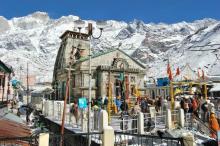
About Kedarnath Temple
In the Chamoli district of Uttarakhand alone, there are over 200 shrines devoted to Lord Shiva, with Kedarnath being the most significant one.
The Kedarnath Temple is a striking sight, positioned on a spacious plateau amidst towering snow-covered peaks. Initially constructed in the 8th century A.D. by Jagad Guru Adi Shankaracharya, it stands near the site of a preexisting temple built by the Pandavas.
Adorning the inner walls of the assembly hall are depictions of various deities and mythological scenes. Just outside the temple door, a substantial statue of the Nandi buffalo stands sentinel.
Devoted to Lord Shiva, the Kedarnath temple boasts remarkable architecture. Crafted from enormous, weighty, and evenly cut grey stone slabs, its construction prompts awe regarding how these hefty blocks were transported and managed in earlier eras.
The temple encompasses a Garbha Griha (sanctum sanctorum) for worship and a Mandap (hall) suitable for congregations of pilgrims and visitors. Within the temple, a conical rock formation is venerated as Lord Shiva in his Sadashiva form.
Kedarnath Mythology
The renowned Kedarnath temple holds significance for pilgrims due to its inclusion in the Char Dham circuit. According to legend, the initial construction of the temple dates back to the time of the Mahabharata, attributed to the Pandava brothers. There are some mythologies about this.
Built by Pandavas
The legendary tale goes that after emerging victorious over the Kauravas in the Kurukshetra war, the Pandavas felt remorse for slaying their own kin.
Seeking absolution, they pursued Lord Shiva for his blessings. Eluding them repeatedly, he sought sanctuary at Kedarnath in the guise of a buffalo.
As the Pandavas followed, Lord Shiva submerged himself into the earth, leaving his hump on the surface at Kedarnath. His other body parts manifested at four distinct locations and are venerated as his incarnations.
Tungnath represents his arms, Rudranath his face, Madmaheshwar his belly, and Kalpeshwar his locks and head. Collectively, Kedarnath and these four shrines are revered as the Panch Kedar (Panch meaning "Five" in Sanskrit).
Bhim Shila - The lifesaver rock
The existence of the rock and its role in safeguarding the temple has given rise to diverse interpretations and beliefs. As per legend, the Bhim Shila was originally positioned by the Pandavas, the legendary figures from the Hindu epic Mahabharata.
According to this narrative, Bhima, one of the Pandava brothers, is said to have pursued Lord Shiva (referred to as Bhole Baba or Kedar Baba) at this very site, and the rock symbolizes his act of protecting Lord Shiva's temple by entombing his mace. This connection with Bhima is the reason behind its name, Bhim Shila.
The safeguarding of the Kedarnath temple by the Bhim Shila remains a subject of amazement and reverence for numerous individuals, encompassing devotees and revered ascetics. This stone is viewed as a representation of the temple's fortitude and serves as a testament to the extraordinary occurrences amid the catastrophic flood.
Kedarnath as Kedar Khand
Kedarnath Temple was once known as Kedar Khand. As per the Vayu Purana, Lord Vishnu assumed the form of Narayan and arrived at Badrinath, where Lord Shiva had his abode.
At the behest of Lord Vishnu, Lord Shiva departed from Badrinath and took residence at Kedarnath.
In the present day, there stands a Vishnu Temple at Badrinath. The primary offering to Lord Shiva is comprised of butter and ghee. Devotees present butter, ghee, and water from Gangotri as offerings. Some also include a bilvapatra coated in silver.
Kedarnath Temple History
According to Hindu tradition, it is firmly believed that Lord Shiva materialized in the form of Jyotirlingam, symbolizing cosmic light. Among the 12 Jyotirlingas, Kedarnath holds the highest significance.
This remarkable temple, constructed over a millennium ago by Jagad Guru Adi Shankaracharya, resides in the Rudra Himalaya range of Uttarakhand State.
Perched at an elevation of 3,581 meters, it involves a 16-kilometer trek from its nearest point, Gaurikund.
Crafted from substantial stone slabs atop a large rectangular platform, the Kedarnath temple is ascended via broad grey steps leading to the sacred sanctums.
Notably, the steps are adorned with inscriptions in the Pali language. Adorning the inner walls of the temple's sanctum are depictions of various deities and mythological scenes.
The roots of the Kedarnath temple can be traced back to the great epic, the Mahabharata.
According to legends, subsequent to emerging victorious in the battle of Mahabharata against the Kauravas, the Pandavas sought Lord Shiva's blessings to absolve themselves of the guilt of killing men during the war.
Lord Shiva persistently eluded them until, while evading them, he sought shelter at Kedarnath in the form of a buffalo. Pursued by the Pandavas, he vanished into the ground at the precise location where the Holy Sanctum now stands, leaving behind his hump visible on the floor.
This hump within the temple materialized into a conical rock formation and is venerated as Lord Shiva in his Sadashiva form. Priests and pilgrims perform rituals and offerings to this manifestation.
Additionally, the temple also houses a Sacred Statue of Lord Shiva, representing a portable embodiment (Utsavar) of the deity.
Best Time To Visit Kedarnath
The sacred town of Kedarnath welcomes visitors from May to October/November, yet the temple remains inaccessible during the monsoon period due to frequent landslides.
☀️Summer (May - June)
Kedarnath, situated at high altitude within the state of Uttarakhand, enjoys a refreshing and agreeable summer climate extending from May to June. Throughout this period, temperatures hover between 10°C to 25°C (50°F to 77°F), rendering it a perfect haven from the sweltering plains' heat.
Summer is the optimal time for sightseeing and embarking on the sacred Kedarnath pilgrimage.
⛈️Monsoon (July - Sep)
From July to September, Kedarnath undergoes a monsoon phase. Throughout this duration, the town encounters substantial rainfall, leading to challenges in traveling and trekking within the vicinity.
This period also brings a heightened risk of landslides and sudden floods, posing potential hazards for tourists.
❄️Winter (October - April)
Throughout the winter period, Kedarnath experiences intensely chilly weather with substantial snowfall.
The average temperature in the winter months (December to February) varies from -2°C to 7°C. In January, temperatures can plummet to as low as -15°C. This is not good time to plan travel.
Official website is - https://badrinath-kedarnath.gov.in
How To Reach Kedarnath
Below are the ways to reach Kedarnath
How to reach Kedarnath by flight
The nearest airport to Kedarnath is Jolly Grant Airport, located at a distance of 235 kilometers and around 35 kilometers from Dehradun. Jolly Grant Airport maintains regular connectivity with Delhi through daily flights. Gaurikund, on the other hand, is easily accessible via well-maintained roads from Jolly Grant Airport. Taxis are readily available for transportation from Jolly Grant Airport to Gaurikund.
How to reach Kedarnath by train
Rishikesh stands as the closest railway station to Gaurikund, positioned 243 kilometers prior to Gaurikund on NH58. Rishikesh's railway station boasts extensive connections with key destinations across India. Frequent train services are available to Rishikesh. Gaurikund is seamlessly linked via well-maintained roads to Rishikesh. Taxis and buses are accessible for travel from Rishikesh, Srinagar, Rudraprayag, Tehri, and various other locations to Gaurikund.
How to reach Kedarnath by road
Gaurikund enjoys strong road connections with key destinations within the state of Uttarakhand. Buses bound for Haridwar, Rishikesh, and Srinagar are accessible from ISBT Kashmiri Gate in New Delhi. Conveniently, buses and taxis plying to Gaurikund are readily accessible from prominent Uttarakhand locations such as Dehradun, Haridwar, Rishikesh, Pauri, Rudraprayag, Tehri, and more. Gaurikund is linked to Ghaziabad via National Highway 58.
Delhi to Kedarnath distance
By Road - 452 Kms
By Flight - 296 Kms
Travel Time by Road is - 9:10 hrs
Nearest Airport in Delhi - Indira Gandhi
Nearest Airport in Kedarnath - Jolly Grant
Rishikesh to Kedarnath distance
By Road - 216 Kms
By Flight - 105 Kms
Travel Time by Road is 5 hrs (approx)
Dehradun to Kedarnath distance
By Road - 254 Kms
By Flight - 109 Kms
Kedarnath to Badrinath distance
By Road - 218 Kms
By Flight - 41 Kms
Travel Time from Kedarnath to Badrinath by Road is - 5 hrs (approx)
Kedarnath registration
Online registration for the Kedarnath pilgrimage can be completed either via the website https://badrinath-kedarnath.gov.in/ or through the official portal of the Uttarakhand Government Tourist Department - https://registrationandtouristcare.uk.gov.in/
Kedarnath helicopter booking
Reservations for helicopter shuttle tickets to Shri Kedarnath Dham can exclusively be made via the official website https://heliyatra.irctc.co.in For more information please check https://heliservices.uk.gov.in/ website. You can also check Seat Availability on this website for the mentioned date.

